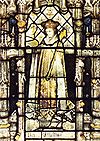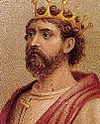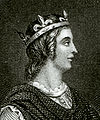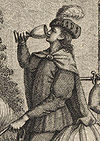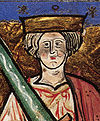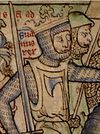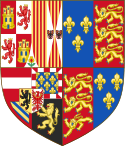
List of English monarchs
Background Information
This Wikipedia selection is available offline from SOS Children for distribution in the developing world. Child sponsorship helps children one by one http://www.sponsor-a-child.org.uk/.
This list of English monarchs begins with Æthelstan. Wessex was the dominant Anglo-Saxon kingdom in the ninth century, and Alfred the Great adopted the title King of the Anglo-Saxons. By the early tenth century his son Edward the Elder controlled southern England, but Northumbria was independent until it was conquered by Æthelstan in 927, and he is regarded by modern historians as the first king of England.
The Principality of Wales was incorporated into the Kingdom of England under the Statute of Rhuddlan in 1284, and in 1301 Edward I invested his eldest son, the future Edward II, as Prince of Wales. Since that time, with the exception of Edward III, the eldest sons of all English monarchs have borne this title. After the death of Elizabeth I without issue, in 1603, the crowns of England and Scotland were joined in personal union under James VI of Scotland, who became James I of England. By royal proclamation James titled himself "King of Great Britain", but no such kingdom was created until 1707, when England underwent legislative union with Scotland to form the United Kingdom of Great Britain, during the reign of Queen Anne.
House of Wessex
House of Knýtlinga
England came under the rule of Danish kings during and following the reign of Æthelred the Unready.
House of Wessex (restored, first time)
Following the death of Sweyn Forkbeard, Æthelred the Unready returned from exile and was again proclaimed king on 3 February 1014. His son succeeded him after being chosen king by the citizens of London and a part of the Witan, despite ongoing Danish efforts in wresting the crown from the West Saxons.
House of Knýtlinga (restored)
Following the decisive Battle of Ashingdon on 18 October 1016, King Edmund signed a treaty with Canute in which all of England except for Wessex would be controlled by Canute. Upon Edmund's death on 30 November, Canute ruled the whole kingdom as its sole king.
| Name | Portrait | Birth | Marriages | Death |
|---|---|---|---|---|
| Cnut (Knútr) 30 November 1016 – 12 November 1035 |
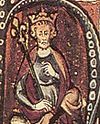 |
c. 995 Son of Sweyn Forkbeard and Gunhilda of Poland |
(1) Aelfgifu of Northampton two children (2) Emma of Normandy 1017 two children |
12 November 1035 Shaftesbury Aged about 40 |
| Harold Harefoot (Harald) 13 November 1035 – 17 March 1040 |
 |
c. 1016/7 Son of Cnut and Ælfgifu of Northampton |
Ælfgifu? 1 son? |
17 March 1040 Oxford Aged about 23 or 24 |
| Harthacnut (Hardeknud) 17 March 1040 – 8 June 1042 |
 |
1018 Son of Cnut and Emma of Normandy |
Unmarried | 8 June 1042 Lambeth Aged about 24 |
House of Wessex (restored, second time)
After Harthacanute, there was a brief Saxon Restoration between 1042 and 1066. After the Battle of Hastings, a decisive point in English history, William I of Normandy became king of England.
| Name | Portrait | Birth | Marriages | Children | Death |
|---|---|---|---|---|---|
| Edward the Confessor (Eadweard) 9 June 1042 – 1066 |
 |
c. 1003 Islip, Oxfordshire Son of Æthelred the Unready and Emma of Normandy |
Edith of Wessex 23 January 1045 |
None | 5 January 1066 Westminster Palace Aged about 63 |
| Harold Godwinson (Harold Godƿinson) 6 January - 14 October 1066 |
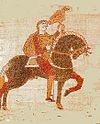 |
c. 1020 Son of Godwin, Earl of Wessex and Gytha Thorkelsdóttir |
Edith Swannesha | Godwine, Edmund, Magnus, Gunhild, Gytha | 14 October 1066 Hastings Aged about 46 (Died in battle) |
| Ealdgyth c. 1064 |
Harold, Ulf | ||||
| Edgar the Ætheling (Eadgar Æþeling) 15 October – 17 December 1066 Proclaimed, but never crowned |
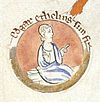 |
c. 1053 Hungary Son of Edward the Exile and Agatha |
Unmarried | None | c. 1125 Aged about 72 |
House of Normandy
In 1066 the Duke of Normandy, William I, a vassal to the King of France and cousin once-removed of Edward the Confessor, invaded and conquered England in the Norman Conquest of England, and made permanent the recent removal of the capital from Winchester to London. Following the death of King Harold II in the decisive Battle of Hastings on 14 October, the Anglo-Saxon witan elected Edgar the Ætheling king in Harold's place, but Edgar was unable to resist the invaders and was never crowned. William was crowned King of England on Christmas Day 1066, and is today known as William the Conqueror, William the Bastard or William I.
It was only from the reign of William and his descendents that monarchs took regnal numbers in the French fashion, though the earlier custom of distinguishing monarchs by nicknames did not die out by consequence.
| Name | Portrait | Birth | Marriages | Death | Claim |
|---|---|---|---|---|---|
| William I William the Bastard William the Conqueror (Guillaume le Bâtard) (Guillaume le Conquérant) 25 December 1066–1087 |
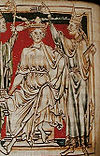 |
c. 1028 Falaise Castle son of Robert I, Duke of Normandy, and Herleva |
Matilda of Flanders Chapel Notre Dame of the castle in Eu, Normandy 1053 ten children |
9 September 1087 Rouen aged about 59 after wounding himself on the saddle when his horse stumbled. Buried at Saint Etienne Abbey ( Abbaye aux Hommes) of Caen |
Supposedly named heir by Edward the Confessor in 1052 (de facto right of conquest) |
| William II William Rufus (Guillaume le Roux) 26 September 1087–1100 |
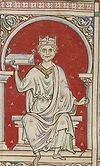 |
c. 1060 Normandy son of William the Conqueror and Matilda of Flanders |
unmarried | 2 August 1100 New Forest aged about 40 when shot by an arrow, events still unclear. |
son of William I (appointment) |
| Henry I Henry Beauclerc (Henri Beauclerc) 5 August 1100–1135 |
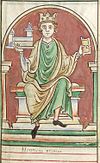 |
September 1068 Selby son of William the Conqueror and Matilda of Flanders |
(1) Edith otherwise Matilda of Scotland Westminster Abbey 11 November 1100 four children (2) Adeliza of Louvain Windsor Castle 29 January 1121 no children |
1 December 1135 Castle of Lyons-la-Forêt (Saint-Denis-en-Lyons) aged 67 apparently from eating a surfeit of lampreys. Buried at Reading Abbey |
son of William I; (seizure of the crown) |
House of Blois
| Name | Portrait | Birth | Marriages | Death | Claim |
|---|---|---|---|---|---|
| Stephen Stephen of Blois (Étienne de Blois) 22 December 1135–1154 |
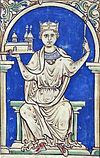 |
c. 1096 Blois son of Stephen, Count of Blois, and Adela of Normandy |
Matilda of Boulogne Westminster 1125 five children |
25 October 1154 Dover Castle aged about 58 from dysentery |
grandson of William I (appointment/usurpation) |
Disputed claimants
Empress Matilda was declared heir presumptive by her father, Henry I, after the death of her brother on the White Ship, and acknowledged as such by the barons. However, upon Henry I's death, the throne was seized by Matilda's cousin, Stephen of Blois. The Anarchy followed, with Matilda's being a de facto ruler for a few months in 1141, but she was never crowned and is rarely listed as a monarch of England.
| Name | Portrait | Birth | Marriages | Death | Claim |
|---|---|---|---|---|---|
| Matilda Empress Matilda (Mathilde l'emperesse) 7 April 1141–1 November 1141 Title disputed |
7 February 1102 Sutton Courtenay daughter of Henry I and Edith of Scotland |
(1) Henry V, Holy Roman Emperor Mainz 6 January 1114 no children (2) Geoffrey V, Count of Anjou Le Mans Cathedral 22 May 1128 three children |
10 September 1167 Notre Dame du Pré in Rouen aged 65 |
daughter of Henry I (seizure of the crown) |
Prince Eustace (c. 1130 – 17 August 1153) was appointed co-king of England by his father, King Stephen, on 6 April 1152, in order to guarantee his succession to the throne (as was the custom in France, but not in England). However, the Church would not agree to this, and Eustace was not crowned. Eustace died the next year aged 22, during his father's lifetime, and so never became king in his own right.
House of Plantagenet
Stephen came to an agreement with Matilda in November 1153 with the signing of the Treaty of Wallingford, where Stephen recognised Henry, son of Matilda, as the heir-apparent to the throne in lieu of his own son.
Rather than ruling among the Normans, the Plantagenets ruled from Aquitaine — lands which were acquired through Henry II's marriage to Eleanor of Aquitaine, but did not regard England as their primary home until after most of their French possessions were lost by King John. This long-lived dynasty is usually divided into three houses: the Angevins, the House of Lancaster and the House of York.
The Plantagenets formulated England's royal coat of arms, which usually showed other kingdoms held or claimed by them or their successors, although without representation of Ireland for quite some time.
| Name | Portrait | Birth | Marriages | Death | Claim |
|---|---|---|---|---|---|
| Henry II Henry Curtmantle (Henri Court-manteau) 19 December 1154–1189 |
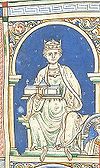 |
5 March 1133 Le Mans son of Geoffrey V of Anjou and Matilda |
Eleanor of Aquitaine Bordeaux Cathedral 18 May 1152 eight children |
6 July 1189 Chinon aged 56. Buried at Fontevraud Abbey |
grandson of Henry I ( Treaty of Wallingford) |
| Henry the Young King (Henri le Jeune Roy) (co-ruler with his father) 14 June 1170–1183 |
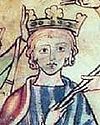 |
28 February 1155 son of Henry II and Eleanor of Aquitaine |
Margaret of France Winchester Cathedral 27 August 1172 one child |
11 June 1183 Martel, Limoges aged 28. Buried at Rouen Cathedral (Notre-Dame) |
son of Henry II ( coronation as junior king) |
| Richard I Richard the Lionheart (Richard Cœur de Lion) 3 September 1189–1199 |
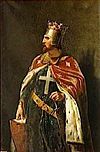 |
8 September 1157 Beaumont Palace son of Henry II and Eleanor of Aquitaine |
Berengaria of Navarre Limassol 12 May 1191 no children |
6 April 1199 Chalus aged 41 from an arrow wound in the shoulder that became infected. Buried: Heart at Rouen Cathedral. Body at Fontevraud Abbey |
son of Henry II ( primogeniture) |
| John Lackland (Jean sans Terre) 27 May 1199–1216 |
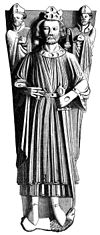 |
24 December 1166 Beaumont Palace son of Henry II and Eleanor of Aquitaine |
(1) Isabel of Gloucester Marlborough Castle 29 August 1189 no children (2) Isabella of Angoulême |
19 October 1216 Newark-on-Trent aged 49, probably from dysentery brought on by eating peaches and drinking wine. Buried at Worcester Cathedral |
brother of Richard I (appointment) |
Disputed claimant
Louis VIII of France briefly ruled about half of England from 1216 to 1217 at the conclusion of the First Barons' War against King John. On marching into London he was openly received by the rebel barons and citizens of London and proclaimed (though not crowned) king at St Paul's cathedral. Many nobles, including Alexander II of Scotland for his English possessions, gathered to give homage to him. However, in signing the Treaty of Lambeth in 1217, Louis conceded that he had never been the legitimate king of England.
| Name | Portrait | Birth | Marriages | Death | Claim |
|---|---|---|---|---|---|
| Louis The Lion 1216– 22 September 1217 Title disputed |
 |
5 September 1187 Paris son of Philip II of France, and Isabella of Hainault |
Blanche of Castile Portmont 23 May 1200 13 children |
8 November 1226 Montpensier aged 39 |
Right of conquest |
| Name | Portrait | Birth | Marriages | Death | Claim |
|---|---|---|---|---|---|
| Henry III Henry of Winchester 28 October 1216–1272 |
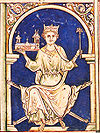 |
1 October 1207 Winchester Castle son of King John and Isabella of Angoulême |
Eleanor of Provence Canterbury Cathedral 14 January 1236 nine children |
16 November 1272 Westminster Palace aged 65 |
son of King John (primogeniture) |
| Edward I Longshanks 20 November 1272–1307 |
 |
17 June 1239 Westminster Palace son of Henry III and Eleanor of Provence |
(1) Eleanor of Castile Abbey of Santa Maria la Real de Huelgas 18 October 1254 17 children (2) Margaret of France |
7 July 1307 Burgh by Sands aged 68 |
son of Henry III (primogeniture) |
| Edward II Edward of Caernarfon 7 July 1307 – 25 January 1327 |
 |
25 April 1284 Caernarfon Castle son of Edward I and Eleanor of Castile |
Isabella of France Boulogne Cathedral 25 January 1308 five children |
21 September 1327 Berkeley Castle aged 43 (murdered) |
son of Edward I (primogeniture) |
| Edward III 25 January 1327–1377 |
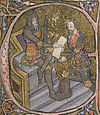 |
13 November 1312 Windsor Castle son of Edward II and Isabella of France |
Philippa of Hainault York Minster 24 January 1328 14 children |
21 June 1377 Sheen Palace aged 64 |
son of Edward II (primogeniture) |
| Richard II 21 June 1377 – 29 September 1399 |
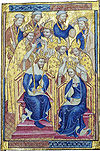 |
6 January 1367 Bordeaux son of Edward, the Black Prince and Joan of Kent |
(1) Anne of Bohemia 14 January 1382 no children (2) Isabella of Valois |
14 February 1400 Pontefract Castle aged 33 probably from starvation |
grandson of Edward III (primogeniture) |
House of Lancaster
This house descended from Edward III's third surviving son, John of Gaunt. Henry IV seized power from Richard II (and also displaced the next in line to the throne, Edmund Mortimer, a descendant of Edward III's second son, Lionel of Antwerp).
| Name | Portrait | Birth | Marriages | Death | Claim |
|---|---|---|---|---|---|
| Henry IV Bolingbroke 30 September 1399–1413 |
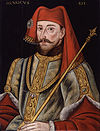 |
3 April 1366/7 Bolingbroke Castle son of John of Gaunt and Blanche of Lancaster |
(1) Mary de Bohun Arundel Castle 27 July 1380 seven children (2) Joanna of Navarre |
20 March 1413 Westminster Abbey aged 45 or 46 |
grandson and heir male of Edward III ( usurpation/ agnatic primogeniture) |
| Henry V 20 March 1413–1422 |
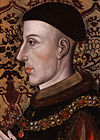 |
16 September 1386 or 9 August 1387 Monmouth Castle son of Henry IV and Mary de Bohun |
Catherine of Valois Troyes Cathedral 2 June 1420 one son |
31 August 1422 Château de Vincennes aged 35 |
son of Henry IV (agnatic primogeniture) |
| Henry VI (first reign) 31 August 1422 – 4 March 1461 |
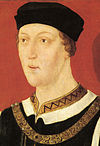 |
6 December 1421 Windsor Castle son of Henry V and Catherine of Valois |
Margaret of Anjou Titchfield Abbey 22 April 1445 1 son |
21 May 1471 Tower of London aged 49 |
son of Henry V (agnatic primogeniture) |
House of York
The House of York inherited its name from the fourth surviving son of Edward III, Edmund, 1st Duke of York, but claimed the right to the throne through Edward III's second surviving son, Lionel of Antwerp.
The Wars of the Roses (1455–1485) saw the throne pass back and forth between the rival houses of Lancaster and York.
| Name | Portrait | Birth | Marriages | Death | Claim |
|---|---|---|---|---|---|
| Edward IV (first reign) 4 March 1461 – 2 October 1470 |
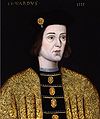 |
28 April 1442 Rouen son of Richard Plantagenet, 3rd Duke of York, and Cecily Neville |
Elizabeth Woodville Grafton Regis 1 May 1464 ten children |
9 April 1483 Westminster Palace aged 40 (probably died of a stroke after catching a chill during a fishing trip) |
great-great-grandson and heir general of Edward III (seizure of the crown/ cognatic primogeniture) |
House of Lancaster (restored)
| Name | Portrait | Birth | Marriages | Death | Claim |
|---|---|---|---|---|---|
| Henry VI (second reign) 30 October 1470 – 11 April 1471 |
 |
6 December 1421 Windsor Castle son of Henry V and Catherine of Valois |
Margaret of Anjou Titchfield Abbey 22 April 1445 1 son |
21 May 1471 Tower of London aged 49 (murdered) by being stabbed in the head. |
son of Henry V (seizure of the crown) |
House of York (restored)
| Name | Portrait | Birth | Marriages | Death | Claim |
|---|---|---|---|---|---|
| Edward IV (second reign) 11 April 1471 – 9 April 1483 |
 |
28 April 1442 Rouen son of Richard Plantagenet, 3rd Duke of York, and Cecily Neville |
Elizabeth Woodville Grafton Regis 1 May 1464 ten children |
9 April 1483 Westminster Palace aged 40 (probably died of a stroke after catching a chill during a fishing trip) |
great-great-grandson and heir general of Edward III (seizure of the crown/ cognatic primogeniture) |
| Edward V 9 April – 25 June 1483 |
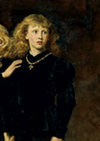 |
2 November 1470 Westminster son of Edward IV and Elizabeth Woodville |
unmarried | c. 1483 London aged about 12 (reportedly smothered) |
son of Edward IV (cognatic primogeniture) |
| Richard III 26 June 1483–1485 |
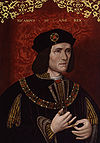 |
2 October 1452 Fotheringhay Castle son of Richard Plantagenet, 3rd Duke of York, and Cecily Neville |
Anne Neville Westminster Abbey 12 July 1472 1 son |
22 August 1485 Bosworth Field aged 32 (killed in battle) |
great-great-grandson of Edward III ( Titulus Regius) |
House of Tudor
The Tudors descended matrilineally from John Beaufort, one of the illegitimate children of John of Gaunt (third surviving son of Edward III), by Gaunt's long-term mistress Katherine Swynford. Those descended from English monarchs only through an illegitimate child would normally have no claim on the throne, but the situation was complicated when Gaunt and Swynford eventually married in 1396 (25 years after John Beaufort's birth). In view of the marriage, the church retroactively declared the Beauforts legitimate via a papal bull the same year (also enshrined in an Act of Parliament in 1397). A subsequent proclamation by John of Gaunt's legitimate son, King Henry IV, also recognized the Beauforts' legitimacy, but declared them ineligible ever to inherit the throne. Nevertheless, the Beauforts remained closely allied with Gaunt's other descendants, the Royal House of Lancaster.
John Beaufort's granddaughter Lady Margaret Beaufort was married to Edmund Tudor. Tudor was the son of Welsh courtier Owain Tewdr (anglicised to "Owen Tudor") and Catherine of Valois, the widowed queen consort of the Lancastrian King Henry V. Edmund Tudor and his siblings were either illegitimate, or the product of a secret marriage, and owed their fortunes to the goodwill of their legitimate half-brother King Henry VI. When the House of Lancaster fell from power, the Tudors followed. By the late 15th century, the Tudors were the last hope for the Lancaster supporters. Edmund Tudor's son became king as Henry VII after defeating Richard III at the Battle of Bosworth Field in 1485, ending the Wars of the Roses.
With Henry VIII's break from the Roman Catholic Church, the monarch became the Supreme Head of the Church of England and of the Church of Ireland. Elizabeth I's title became the Supreme Governor of the Church of England.
| Name | Portrait | Birth | Marriages | Death | Claim |
|---|---|---|---|---|---|
| Henry VII 22 August 1485–1509 |
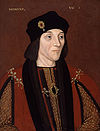 |
28 January 1457 Pembroke Castle son of Edmund Tudor and Lady Margaret Beaufort |
Elizabeth of York Westminster Abbey 18 January 1486 eight children |
21 April 1509 Richmond Palace aged 52 |
great-great-great-grandson of Edward III ( right of conquest) |
| Henry VIII 21 April 1509–1547 |
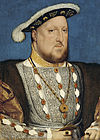 |
28 June 1491 Greenwich Palace son of Henry VII and Elizabeth of York |
Catherine of Aragon Greenwich 11 June 1509 one daughter |
28 January 1547 Whitehall Palace aged 55 |
son of Henry VII ( primogeniture) |
| Anne Boleyn Westminster Palace 25 January 1533 one daughter |
|||||
| Jane Seymour Whitehall Palace 30 May 1536 one son |
|||||
| Anne of Cleves Greenwich Palace 6 January 1540 |
|||||
| Catherine Howard Hampton Court Palace 28 July 1540 |
|||||
| Catherine Parr Hampton Court Palace 12 July 1543 |
|||||
| Edward VI 28 January 1547–1553 |
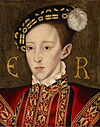 |
12 October 1537 Hampton Court Palace son of Henry VIII and Jane Seymour |
unmarried | 6 July 1553 Greenwich Palace aged 15 |
son of Henry VIII ( primogeniture) |
Disputed claimant
Edward VI named Lady Jane Grey as his heir presumptive. Four days after his death on 6 July 1553, Jane was proclaimed queen. Nine days after the proclamation, on 19 July, the Privy Council switched allegiance and proclaimed Edward VI's Catholic half-sister Mary. Jane was executed in 1554, aged 16. Many historians do not consider her to have been a legitimate monarch.
| Name | Portrait | Birth | Marriages | Death | Claim |
|---|---|---|---|---|---|
| Jane 10–19 July 1553 Title disputed |
 |
October 1537 Bradgate Park daughter of Henry Grey, 1st Duke of Suffolk, and Lady Frances Brandon |
Lord Guildford Dudley The Strand 21 May 1553 no children |
12 February 1554 Tower of London aged 16 (beheaded) |
great-granddaughter of Henry VII (Devise for the succession) |
| Name | Portrait | Birth | Marriages | Death | Claim |
|---|---|---|---|---|---|
| Mary I 19 July 1553–1558 |
 |
18 February 1516 Greenwich Palace daughter of Henry VIII and Catherine of Aragon |
Philip II of Spain Winchester Cathedral 25 July 1554 no children |
17 November 1558 St. James's Palace aged 42 |
daughter of Henry VIII ( Third Succession Act) |
| Philip 25 July 1554 – 17 November 1558 ( jure uxoris) |
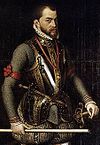 |
21 May 1527 Valladolid, Spain son of Charles V, Holy Roman Emperor, and Isabella of Portugal |
(2) Mary I of England Winchester Cathedral 25 July 1554 no children three other marriages and seven children |
13 September 1598 El Escorial, Spain aged 71 |
husband of Mary I ( Act for the Marriage of Queen Mary to Philip of Spain) |
Under the terms of the marriage treaty between Philip I of Naples (Philip II of Spain from 15 January 1556) and Queen Mary I, Philip was to enjoy Mary's titles and honours for as long as their marriage should last. All official documents, including Acts of Parliament, were to be dated with both their names, and Parliament was to be called under the joint authority of the couple. An Act of Parliament gave him the title of king and stated that he "shall aid her Highness ... in the happy administration of her Grace’s realms and dominions" (although elsewhere the Act stated that Mary was to be "sole queen"). Nonetheless, Philip was to co-reign with his wife. As the new King of England could not read English, it was ordered that a note of all matters of state should be made in Latin or Spanish. Coins were minted showing the heads of both Mary and Philip, and the coat of arms of England (right) was impaled with Philip's to denote their joint reign. Acts which made it high treason to deny Philip's royal authority were passed in England and Ireland. In 1555, Pope Paul IV issued a papal bull recognising Philip and Mary as rightful King and Queen of Ireland.
| Name | Portrait | Birth | Marriages | Death | Claim |
|---|---|---|---|---|---|
| Elizabeth I 17 November 1558–1603 |
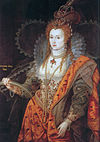 |
7 September 1533 Greenwich Palace daughter of Henry VIII and Anne Boleyn |
unmarried | 24 March 1603 Richmond Palace aged 69 |
daughter of Henry VIII ( Third Succession Act) |
House of Stuart
Following the death of Elizabeth I in 1603 without issue, the Scottish king, James VI, succeeded to the English throne as James I in the Union of the Crowns. James was descended from the Tudors through his great-grandmother, Margaret Tudor, the eldest daughter of Henry VII. In 1604 he adopted the title King of Great Britain. However the two parliaments remained separate.
| Name | Portrait | Birth | Marriages | Death | Claim |
|---|---|---|---|---|---|
| James I 24 March 1603–1625 |
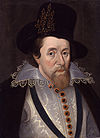 |
19 June 1566 Edinburgh Castle son of Henry Stuart, Lord Darnley, and Mary I, Queen of Scots |
Anne of Denmark Oslo 23 November 1589 seven children |
27 March 1625 Theobalds House Aged 58 |
great-great-grandson and heir general of Henry VII |
| Charles I 27 March 1625–1649 |
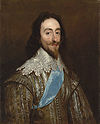 |
19 November 1600 Dunfermline Palace son of James I and Anne of Denmark |
Henrietta Maria of France St Augustine's Abbey 13 June 1625 nine children |
30 January 1649 Whitehall Palace aged 48 (beheaded) |
son of James I ( cognatic primogeniture) |
Commonwealth
There was no reigning monarch between the execution of Charles I in 1649 and the Restoration of Charles II in 1660. Instead, from 1653 the following individuals held power as Lords Protector, during the period known as the Protectorate, when the monarchy was overthrown.
| Name | Portrait | Birth | Marriages | Death |
|---|---|---|---|---|
| Oliver Cromwell Old Ironsides 16 December 1653–1658 |
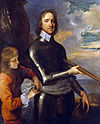 |
25 April 1599 Huntingdon son of Robert Cromwell and Elizabeth Steward |
Elizabeth Bourchier in St Giles 22 August 1620 nine children |
3 September 1658 Whitehall aged 59 |
| Richard Cromwell Tumbledown Dick 3 September 1658 – 7 May 1659 |
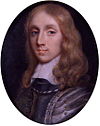 |
4 October 1626 Huntingdon son of Oliver Cromwell and Elizabeth Bourchier |
Dorothy Maijor May 1649 nine children |
12 July 1712 Cheshunt aged 85 |
House of Stuart (restored)
Although the monarchy was restored in 1660, no stable settlement proved possible until the Glorious Revolution of 1688, when Parliament finally asserted the right to choose whomsoever it pleased as monarch.
| Name | Portrait | Birth | Marriages | Death | Claim |
|---|---|---|---|---|---|
| Charles II 1660–1685 Recognized by Royalists in 1649 |
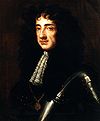 |
29 May 1630 St. James's Palace son of Charles I and Henrietta Maria of France |
Catherine of Braganza Portsmouth 21 May 1662 no children |
6 February 1685 Whitehall Palace aged 54 |
son of Charles I ( cognatic primogeniture; English Restoration) |
| James II 6 February 1685 – 23 December 1688 (deposed) |
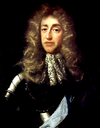 |
14 October 1633 St. James's Palace son of Charles I and Henrietta Maria of France |
(1) Anne Hyde The Strand 3 September 1660 eight children (2) Mary of Modena |
16 September 1701 Château de Saint-Germain-en-Laye aged 67 |
son of Charles I ( cognatic primogeniture) |
| Mary II 13 February 1689–1694 |
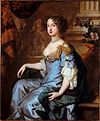 |
30 April 1662 St. James's Palace daughter of James II and Anne Hyde |
St. James's Palace 4 November 1677 no children |
28 December 1694 Kensington Palace aged 32 |
grandchildren of Charles I (offered the crown by Parliament) |
| William III William of Orange 13 February 1689–1702 |
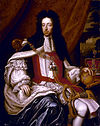 |
4 November 1650 The Hague son of William II, Prince of Orange, and Mary, Princess Royal |
8 March 1702 Kensington Palace aged 51 after breaking his collarbone from falling off his horse |
||
| Anne 8 March 1702–1 May 1707 Queen of Great Britain and Ireland 1 May 1707–1 August 1714 |
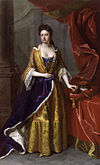 |
6 February 1665 St. James's Palace daughter of James II and Anne Hyde |
George of Denmark St. James's Palace 28 July 1683 5 children |
1 August 1714 Kensington Palace aged 49 |
daughter of James II ( cognatic primogeniture; Bill of Rights 1689) |
Monarchs after 1707
For monarchs after the union of England and Scotland in 1707, see List of British monarchs.
Acts of Union
The Acts of Union 1707 were a pair of Parliamentary Acts passed during 1706 and 1707 by the Parliament of England and the Parliament of Scotland to put into effect the terms of the Treaty of Union that had been agreed on 22 July 1706, following negotiation between commissioners representing the parliaments of the two countries. The Acts joined the Kingdom of England and the Kingdom of Scotland (previously separate states, with separate legislatures but with the same monarch) into a single Kingdom of Great Britain.
The two countries had shared a monarch for about 100 years (since the Union of the Crowns in 1603, when King James VI of Scotland inherited the English throne from his first cousin twice removed, Queen Elizabeth I). Although described as a Union of Crowns, until 1707 there were in fact two separate Crowns resting on the same head. There had been three attempts in 1606, 1667, and 1689 to unite the two countries by Acts of Parliament, but it was not until the early eighteenth century that the idea had the will of both political establishments behind them, albeit for rather different reasons.
Timeline of English Monarchs

Titles
The standard title for all monarchs from Alfred the Great until the time of King John was Rex Anglorum ("King of the English"). In addition, many of the pre-Norman kings assumed extra titles, as follows:
- Alfred the Great: Rex Angulsaxonum ("King of the Anglo-Saxons") and Rex Anglorum et Saxonum ("King of the Angles and Saxons")
- Athelstan: Rex Anglorum per omnipatrantis dexteram totius Bryttaniæ regni solio sublimatus ("King of the English and for accomplishing every right raised to the throne of Britannia")
- Edmund the Magnificent: Rex Britanniae ("King of Britain") and Rex Anglorum caeterarumque gentium gobernator et rector ("King of the English and of other peoples governor and director")
- Edred: Regis qui regimina regnorum Angulsaxna, Norþhymbra, Paganorum, Brettonumque ("Reigning over the governments of the kingdoms of the Anglo-Saxons, Northumbrians, Pagans, and British")
- Edwy the Fair: Rex nutu Dei Angulsæxna et Northanhumbrorum imperator paganorum gubernator Breotonumque propugnator ("King by the will of God, Emperor of the Anglo-Saxons and Northumbrians, governor of the pagans, commander of the British")
- Edgar the Peaceable: Totius Albionis finitimorumque regum basileus ("Autocrat of all Albion and its neighboring realms")
- Canute: Rex Anglorum totiusque Brittannice orbis gubernator et rector ("King of the English and of all the British sphere governor and director") and Brytannie totius Anglorum monarchus ("Monarch of all the English of Britain")
In the Norman period Rex Anglorum remained standard, with occasional use of Rex Anglie ("King of England"). The Empress Matilda styled herself Domina Anglorum ("Lady of the English").
From the time of King John onwards all other titles were eschewed in favour of Rex or Regina Anglie.
In 1604 James I, who had inherited the English throne the previous year, adopted the title (now usually rendered in English rather than Latin) King of Great Britain. The English and Scottish parliaments, however, did not recognise this title until the Acts of Union of 1707 under Queen Anne (who was of course Queen of Great Britain rather than king).

